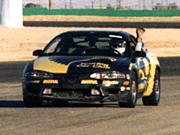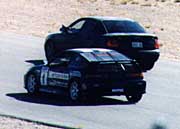Article Topics:
- Overview
- Intro to Racing
- Driving Technique
- Practice Sessions
- Driver’s Gear
- Vehicle Safety
- Handling
- Brakes
- Power
- Tools
TurnFast
recommends
these books:
Articles for Getting Started in Racing
Track Protocol
Communication between drivers on the track is critical for maintaining safety. There's a few things about general protocol and courtesy that you must be aware of and use while time trial or hot lap driving on a track.
Don't hold up a faster car. Time trialing club rules will invariably include no passing in corners, and depending on the track, faster cars will not necessarily be able to easily pass you on the straights. If a car catches up to you in the corners, but you can pull away on the straights, then the other car is still faster overall. Slow down on the straight (yes, that means let up on the gas), and let the other car pass.
Raise your arm to communicate significant slowing in an unsual spot. If you are slowing more than usual or in an unusual place for any reason (trouble with your car, you see debris, or a car in trouble ahead, or you're planning on pulling into the pits), raise your right arm so your hand and forearm are visible through the rear window. If you're just letting off the gas to slow down in an unusual place, touch the brake pedal so the lights show. Clubs with a majority of street cars often prefer drivers raise their left arm out the window. It is more visible, but under race conditions the window would have a net, so get in the habit of using and looking for the right arm inside the car if you plan to move up to a racing class.
Get off the racing line if your car has problems. If you're having trouble with the car, or are going to pull into the pits, drive the car off the racing line. That is, do not stay driving on the normal path you would use when racing. Stay out of the way of other cars by driving where they are not likely to be.
Let faster cars know its OK to pass. As time trial driving typically does not allow passing in the corners, it is important to communicate with other drivers that you are aware of their presence and need to pass. Even when there is no passing in corners you should develop the habit of checking your mirrors. Someone may have brake troubles, or may simply get in over their head thinking they could have passed you before the corner. If you see someone needing to pass, wave your hand and point the driver behind to the side of the car you want to be passed on.
Whether passing is done on the left or the right can depend on a few factors. The club you run with should have very clear rules about this. Usually the safest rule is to have the car doing the overtaking make the pass off the racing line. The slower car stays on the racing line. In club time trialing, with many driver's not having much track experience, the slower car may not even be aware of the faster car, and this rule helps to avoid accidents due to miscommunication.
Keep your cool and use the race steward to mediate if you need to. Time trial racing, like anything else, will have its hot-dogs that don't believe the rules apply to them. If a driver obviously ignores the rules, and is compromising his and your safety with his driving, you owe it to both of you to complain about it. You have two choices: you can complain directly to the driver, or do it through an event official, typically the race steward. Which you do depends on you. If you can engage in a conversation politely reminding the driver of the rules that perhaps he wasn't aware of, then by all means, you'll probably make a friend out of it. Sometimes what appeared to you as an aggressive move, was due to misunderstanding or maybe even car trouble. If, however, you suspect that either you or the other driver is likely to get a little heated over the discussion, then it's better to use an official as your liaison until cooler heads can prevail.
The nearest visible corner worker is your commnication point when you go off the track. If you spin off the track, once you have stopped, give a "thumbs up" to the nearest corner worker to indicate you're not hurt. If you do not move the car, and if you do not motion to a corner worker, the track officials will assume you need assistance. If your car is not damaged, and you're OK, position the car so you can see the nearest corner worker, and he can see you. The corner worker will let you know when it is clear to enter the track. If he holds up a few fingers, he's telling you how many cars will pass before you can go. Enter the track slowly, and off the racing line if possible. Do not spin the tires -- this will just spray debris all over the track and cause delays to get it cleaned up.
On or off the track, never drive against traffic. When you spin off the track, and want to get back to the pits, never drive against the flow of traffic on the track or even off the track. Even if the nearest exit is just a few yards back, drive with the flow of traffic to the next exit -- even if it is all the way around the track. If your car is damaged, stay put until the session is stopped. You don't want to end up in a worse position, and you don't want to be dropping car parts or fluids on the track, or increasing the damage by driving the car.
Never back up in the hot pit unless directed to do so by a track official. The hot pit is part of the track, and part of the one-way flow of traffic.
Read Next Article (Vehicle Modifications)
Tags: Race Driving, Racing Schools, High performance Driving Schools

A raised arm is a universal signal that indicates a car is slowing well below the racing pace. In the photo above, the driver is heading into the pits. In the photo below, the car on the right may be having trouble and has pulled off the racing line. The driver is waving the second car by.
Many clubs want the left arm out the window. However, if your car has a window net, and in racing classes where they all do, the proper signal is to use the right arm between the seats. It's a good idea to wave your arm a little to be sure the driver behind notices.

